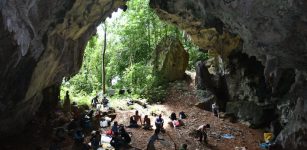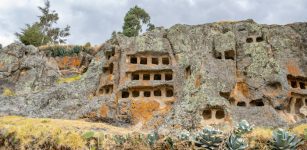La Garma Cave Offers Evidence Of Over 300,000 Years Of Human Activity
Jan Bartek - AncientPages.com - One of the most fascinating ancient caves in Europe can be found in Cantabria in Northern Spain. Known as the cave of La Garma, this intriguing site offers evidence of over 300,000 years of human activity.
La Garma virtual tour. Still shots from World Monuments Fund.
When archaeologists investigated the cave, they discovered an impressive collection of rock art and archaeological remains from the Paleolithic age. During a recent study conducted by Professor Pablo Arias and Roberto Ontañón from the University of Cantabria, a 16,800-year-old Palaeolithic dwelling was found inside the La Garma cave. According to scientists, it is one of the best-preserved Paleolithic dwellings in the world.
La Garma's Paleolithic dwelling is about 5 square meters. The ancient cave "house" is delimited by an alignment of stone blocks and stalagmites that are fixed to the ground, a structure of sticks and skins leaning against a nearby cornice of the cave wall. In the center of the cave-dwelling, there was a small bonfire. At the site, scientists discovered a multitude of vestiges of various daily activities associated with Magdalenian hunters and gatherers.
So far, the research team has documented 4,614 objects unearthed inside the La Garma cave. Most of these ancient objects are bones of deer, horses, and bison, but there are also 600 pieces of flint, needles, shells of marine mollusks, a protoharpoon, and several pendants that the inhabitants of the house wore as ornaments.
The science team was impressed with the decorated bones. Among them is a spectacular pierced auroch phalanx with an engraved representation of this same animal and a human face. It is a unique piece made by Paleolithic humans in Europe.
16,800-year-old Palaeolithic dwelling found inside the La Garma cave. Credit: University of Cantabria
In order to preserve this exceptional testimony of prehistory for future generations, an innovative methodology has been applied based on the application of non-invasive techniques, such as 3D cartography, molecular and genetic analysis of soils and paleolithic objects, the determination of faunal remains from mass spectrometry on bone collagen (ZooMS) or the hyperspectral analysis of images.
There are now plans to install a reconstruction of the La Garma cave house in the exhibition facility of the Rock Art Center created by the Government of Cantabria in the town of Puente Viesgo.
Discovered in 1995, the cave's Lower Gallery contains the world's largest example of Paleolithic floors. The Lower Gallery, which scientists divided into nine zones, is situated at 59 m (194 ft) above sea level and is around 300 m (984 ft) in length. Thousands of animal bones and sea shells were found in this section, including Lithic, antler, and bone artifacts.
One of the most impressive artifacts found here is a backward-facing ibex depiction carved onto a bovine rib spatula.
The Magdalenian Lower Gallery cave floor is one of the best preserved Paleolithic cave floors ever discovered, and thus of great interest to paleoanthropologists. The rock art has remained in an extraordinary state of conservation much due to the landslide that sealed the cave approximately 15,000 years ago.
La Garma has not only been occupied by Paleolithic humans. As years passed, the cave diminished, but it was still in use by Neolithic people. Through the Bronze Age, it became mainly a burial site. Maybe one of the most peculiar discoveries is the remains of five Visigothic youths were found deep in the cave system. After the bodies had turned into skeletons, all of the individuals' skulls had been crushed quite deliberately.
Undoubtedly, remarkable events have occurred in the La Grama cave for more than 300,000 years.
Visitors to La Garma are offered the opportunity to explore the cave’s interior through virtual reality tours. The VR experiences are not only unforgettable but also ensure that the fragility of the cave is protected.
Written by Jan Bartek - AncientPages.com Staff Writer
Copyright © AncientPages.com All rights reserved. This material may not be published, broadcast, rewritten or redistributed in whole or part without the express written permission of AncientPages.com
Expand for referencesMore From Ancient Pages
-
 Vatican Secrets – Extraterrestrial Life And Genetically Engineering Of Humans By Advanced Alien Species
Featured Stories | Oct 6, 2018
Vatican Secrets – Extraterrestrial Life And Genetically Engineering Of Humans By Advanced Alien Species
Featured Stories | Oct 6, 2018 -
 Mississippi’s Mounds Built By The Indigenous People Are Incredibly Important Landforms – Scientists Say
Archaeology | Jul 25, 2023
Mississippi’s Mounds Built By The Indigenous People Are Incredibly Important Landforms – Scientists Say
Archaeology | Jul 25, 2023 -
 Gaocheng: China’s Oldest Observatory And Large Gnomon Installation Of The Ancients
Ancient Technology | Nov 5, 2016
Gaocheng: China’s Oldest Observatory And Large Gnomon Installation Of The Ancients
Ancient Technology | Nov 5, 2016 -
 DNA Study Shows Pre-Historic Wallacea Was A Melting Pot Of Human Genetic Ancestries
Archaeology | Jun 9, 2022
DNA Study Shows Pre-Historic Wallacea Was A Melting Pot Of Human Genetic Ancestries
Archaeology | Jun 9, 2022 -
 Were Owl-Shaped Plaques Children’s Toys In Copper Age?
Archaeology | Dec 1, 2022
Were Owl-Shaped Plaques Children’s Toys In Copper Age?
Archaeology | Dec 1, 2022 -
 Ancient Maya Ruins Of Tulum: Sea Port And Sacred Site For Worshiping Of Descending God
Featured Stories | Aug 10, 2016
Ancient Maya Ruins Of Tulum: Sea Port And Sacred Site For Worshiping Of Descending God
Featured Stories | Aug 10, 2016 -
 These Curious Burials Could Challenge Historians’ Ideas About Anglo-Saxon Gender
Featured Stories | Oct 3, 2023
These Curious Burials Could Challenge Historians’ Ideas About Anglo-Saxon Gender
Featured Stories | Oct 3, 2023 -
 Mystery Of The Lost Underground City Of The Grand Canyon
Featured Stories | Nov 19, 2014
Mystery Of The Lost Underground City Of The Grand Canyon
Featured Stories | Nov 19, 2014 -
 On This Day In History: Ceiling Of The Sistine Chapel, Painted By Michelangelo, Is Shown Publicly For The First Time – On Nov 1, 1512
News | Nov 1, 2016
On This Day In History: Ceiling Of The Sistine Chapel, Painted By Michelangelo, Is Shown Publicly For The First Time – On Nov 1, 1512
News | Nov 1, 2016 -
 Impressive 2,700-Year-Old Farmhouse And 1,500-Year-Old Monastery Uncovered In Rosh Ha-‘Ayin
Archaeology | Dec 30, 2015
Impressive 2,700-Year-Old Farmhouse And 1,500-Year-Old Monastery Uncovered In Rosh Ha-‘Ayin
Archaeology | Dec 30, 2015 -
 Why Did Modern Humans Replace The Neanderthals? The Key Might Lie In Our Social Structures
Featured Stories | Jun 18, 2024
Why Did Modern Humans Replace The Neanderthals? The Key Might Lie In Our Social Structures
Featured Stories | Jun 18, 2024 -
 Evolution Of Paleodiet At Neolithic Qujialing Site Unveiled By Scientists
Archaeology | Nov 30, 2022
Evolution Of Paleodiet At Neolithic Qujialing Site Unveiled By Scientists
Archaeology | Nov 30, 2022 -
 Fascinating Artificial Caves Of Ventanillas de Otuzco And Its Secret Passageways – Pre-Inca Necropolis Of The Cajamarca Culture
Featured Stories | Feb 5, 2022
Fascinating Artificial Caves Of Ventanillas de Otuzco And Its Secret Passageways – Pre-Inca Necropolis Of The Cajamarca Culture
Featured Stories | Feb 5, 2022 -
 Is Legendary Norumbega In North America A Lost Viking Settlement?
Featured Stories | Jan 8, 2021
Is Legendary Norumbega In North America A Lost Viking Settlement?
Featured Stories | Jan 8, 2021 -
 Incredible Ancient Metallurgical Wonders That Defy Explanation And Pose A Real Mystery Even Today
Civilizations | Apr 21, 2014
Incredible Ancient Metallurgical Wonders That Defy Explanation And Pose A Real Mystery Even Today
Civilizations | Apr 21, 2014 -
 Yggdrasil: Eternal And Sacred Tree Of Life In Norse Mythology
Featured Stories | Sep 22, 2016
Yggdrasil: Eternal And Sacred Tree Of Life In Norse Mythology
Featured Stories | Sep 22, 2016 -
 Collapse Of Akkadian Empire Strongly Related To Catastrophic Climate Change
Archaeology | Oct 28, 2019
Collapse Of Akkadian Empire Strongly Related To Catastrophic Climate Change
Archaeology | Oct 28, 2019 -
 Secrets Of An Ancient Greek City Revealed
Archaeology | Mar 11, 2025
Secrets Of An Ancient Greek City Revealed
Archaeology | Mar 11, 2025 -
 Asenath And The Golden Tablet That Changed Her Destiny
Biblical Mysteries | May 10, 2019
Asenath And The Golden Tablet That Changed Her Destiny
Biblical Mysteries | May 10, 2019 -
 Ancient Egyptian Blue Used To Create New Nanomaterial 100,000 Times Thinner Than A Human Hair
Ancient Technology | Mar 24, 2020
Ancient Egyptian Blue Used To Create New Nanomaterial 100,000 Times Thinner Than A Human Hair
Ancient Technology | Mar 24, 2020


